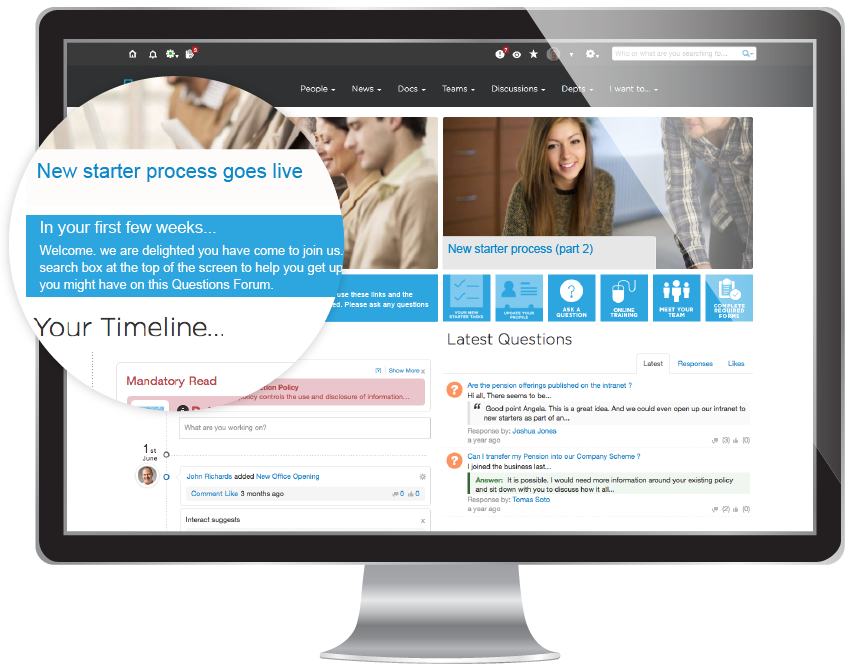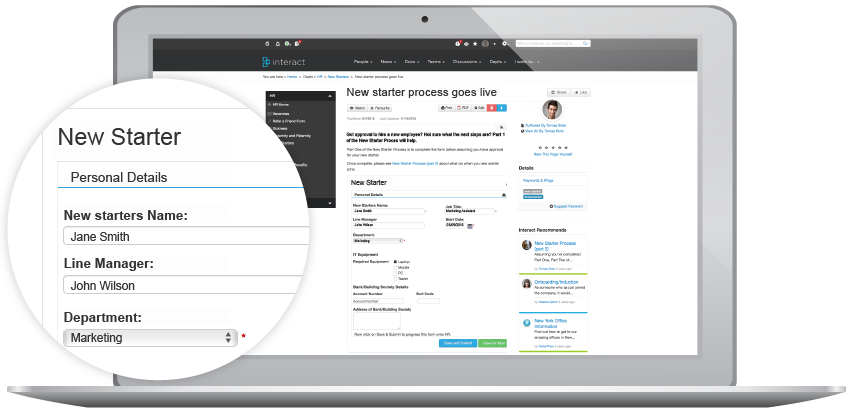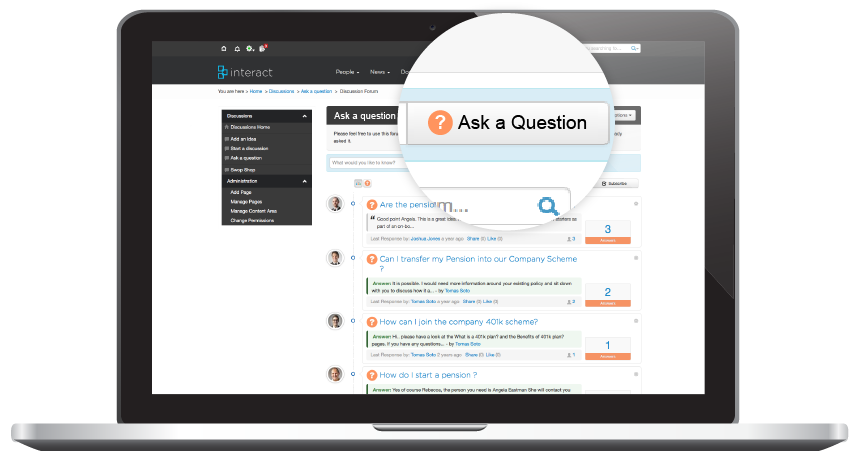10 top tips for onboarding new employees
Over the past few years, more and more businesses have been acknowledging the worldwide deficit in employee engagement, with studies continuously estimating that nearly 70% of workers remain either not engaged or actively disengaged. The number of engaged employees dips below 30% for groups such as millennials and public sector workers. The consequences of disengagement are also well documented, costing businesses in the U.S. alone between $450 and $550 billion every year. What’s more, replacing an employee who has quit or been fired costs up to 150% of that employee’s annual salary.
With those scary statistics, it’s no wonder that companies have extra motivation to confront engagement issues head on before they get significantly worse (and with numbers even more dire among millennials, they certainly would). Companies are taking steps to not only keep employees happy, but to equip them with tools to ensure their success. Aside from directly improving productivity for the sake of the organization, a helping hand toward success lets employees know they are valued and hopefully avoids high costs associated with turnover.
It’s widely acknowledged that beginning employee success efforts late will not produce sufficient results; conversely, starting employees on the right foot from day one (and before) produces workers with long and fruitful careers that also generate the most return on investment for their organizations. For these reasons, it would be wise for companies to focus on onboarding practices as a key component to their engagement and general strategic operations. Unfortunately, onboarding can be a little understood and rarely well executed process. It’s important to note that it is not equivalent to employee orientation, where new hires are given a handbook and sent on their way after a brief introduction to the organization. Onboarding is a more thorough and extensive process, which lasts much longer and utilizes many different ways to welcome new employees to ensure their smooth transition.
Here is a list of our 10 top tips for onboarding new employees, covering many practices to make new hires a truly integral part of your organization and ensuring success for years to come.
1. Don’t wait for their first day
The first day of work is always nerve-racking. There’s so much to remember, and you have no idea whether your colleagues will like you or whether the job will be all that you hoped upon receiving an offer. If an employee gets to this first day, however, already having been accepted as part of the team and understanding some of the team dynamics, as well as how their day to day will soon look, they will be much better equipped to dive in and ramp up quickly to their full productive potential. From the time an offer is made, managers should include new hires in team communications. They should send materials that they feel will help get new employees up to speed both in terms of job duties and the team dynamics and politics. If your company has an intranet solution or internal communications platform, it may be beneficial to grant early access to new employees, who can browse and get a feel for company and team information at their own pace. By including the new hire in team communications, you can also ensure that they get to know their coworkers and feel more included by the time they begin work.

2. Prepare managers, not just new hires
In beginning onboarding prior to a new employee’s first day of work, it’s important that the new hire isn’t the only one targeted in the process. Google’s unique onboarding practices were informed by its own data collection and analytics, which are some of the best in the world. Google determined five actions that managers can take to speed up the onboarding process to have employees fully productive 25% faster than before. HR now sends all managers of new hires an email with this checklist prior to the employee’s first day. That checklist includes having a discussion around roles and responsibilities, matching the new hire with a buddy/mentor, helping the new hire build a social network, setting up onboarding check-ins once a month for the first six months, and encouraging open dialogue. Whether or not the manager chooses to take action is up to them, and they are not forced to do anything with this information. Obviously, though, it will reflect well on them if their new employee is productive and successful early on. An important takeaway from Google’s practice is that employees shouldn’t be viewed as a unit unto themselves – if they are understood as an integral component of the team, to which the manager also belongs, success is easier to achieve.

3. Teach team dynamics – but not biases!
New hires should learn the inner workings of both the company and their team as early as possible. Each organization, and each team within an organization, has its own rules and politics. These are often brought about by a mixture of personalities and the unique field in which the company operates. They can be constructive by helping to streamline processes and ensure that everyone works well together, and office politics need not be understood purely as a negative. Teaching new employees to navigate those intricacies is important, especially considering that this may take much longer to acclimate to than duties of the job. However, it’s important to note that there is a right and a wrong way to teach new employees about office politics. This may seem obvious, but it can sometimes be difficult to teach about interpersonal relations in an office without passing on your own biases that have been developed in your time there. A new hire will look up to the person educating them as somewhat of a role model, especially in the critical first couple weeks. Make sure to get them started on the right foot by educating them in the healthiest way possible.
4. Define expectations
Ambiguity is a poor way to begin a new job and greatly increases the amount of time needed to get to full productive power. Unfortunately, employee handbooks and a job description are usually what suffices for guidelines, which leaves ambiguity in abundance for all new employees. Managers in the hiring process should develop a complete set of guidelines and expectations that includes topics such as deadlines and how deliverables will contribute to team and company goals. This should be as robust as possible but should be a living document, which is revised throughout the interview process and in talks with a new employee. It should also cover company culture, rather than just team-specific issues.
Zappos does an impressive job of educating new employees on company culture and expectations. They offer new employees a five-week course, which surely does more to onboard them than a one-day orientation and their job description. At the end of the course, the company even offers $2000 to any employee that thinks they are a poor fit.
5. Schedule check-ins
It should go without saying that onboarding is an ongoing process. This tip is the other side of the coin to our suggestion of starting onboarding before an employee’s first day. Onboarding must extend even beyond the point when employees are perceived as being “up to speed.” This is not to say that it should go on forever, but it’s better to be certain that the process has worked fully. The best way to do this is to schedule regular check-ins between the new hire and their manager. These should be a dialogue, covering both the employee’s and manager’s assessment of the progress they have made. This is a time to revisit expectations and to set new ones. If done well, it will keep the new hire on track and avoid any snags in their path to success.
6. Assign a mentor
This was briefly mentioned in Google’s new employee checklist, but mentors can be greatly helpful for new employees. Having a high performing employee to show someone the ropes greatly contributes to their odds for success. This person should be available to answer all questions that arise and to take a more personal interest than a manager may be able to. Moreover, this relationship will help a new hire to feel accepted socially and give them a positive role model in the office.
7. Make sure they get to know the team
A new employee’s team is going to become not only the people they work with side by side, but their family. They may end up developing relationships on their team that last for years to come, even beyond their employment at this organization. A positive experience not only ensures their engagement but sets them up with the tools they need to learn and succeed in their new role. Guardian Removals, a UK organization, has a very unique first-day tradition that helps break the ice between new employees and the rest of their team. The whole company takes them on a walk around their office park to a restaurant, where they’re prompted to order for the whole team. The company attests that it is always an entertaining look into their personality.
8. Consider the questions you’ll be asked
New employees are full of questions. They’re adjusting to a new culture, a new jargon, new coworkers, new tasks, and more. It’s inevitable that they’ll be confused and need guidance at some point. While an environment of openness and comfort in asking questions should be encouraged, there are ways for companies to productively get ahead of some questions. By asking themselves what may confuse employees, they can create an FAQ. This may even make employees feel more comfortable asking for the help they need when they see that others have been in their position before. Fog Creek uses their company message boards and task management system to host their FAQ, along with a host of tasks for new employees to complete and get themselves up to speed.

9. Demystify your jargon
Every company has its own language, its corporate jargon. This is often one of the most challenging things for new employees to understand. Percolate attack this issue with their company’s wiki page, which includes a glossary of company-specific terms. On the first day, all employees are introduced to this page, which helps them navigate their new surroundings.
10. Allow for boomerang hires
Who would better be equipped to adjust quickly to your organization and become a productive employee than someone who has already learned its ins and outs. More and more companies are allowing, even encouraging, so called “boomerang hires”. Those are employees who previously worked for the company and left, only to eventually return. The advantage to these employees is that they have a drastically reduced onboarding period and may even return as much more mature and skilled workers. DaVita encourages employees to return by including an offboarding process in addition to their onboarding. They let workers know that they are encouraged to return even after they have moved on to other positions. 15% do become boomerang hires, showing that DaVita’s practice works.
Regardless of the organization, onboarding, and getting a best-of-breed onboarding solution, are important. It keeps employees engaged and ensures a short time to build them up before they are productive. Take these tips as the beginning of your onboarding strategy and build on them to ensure success for all new hires.
